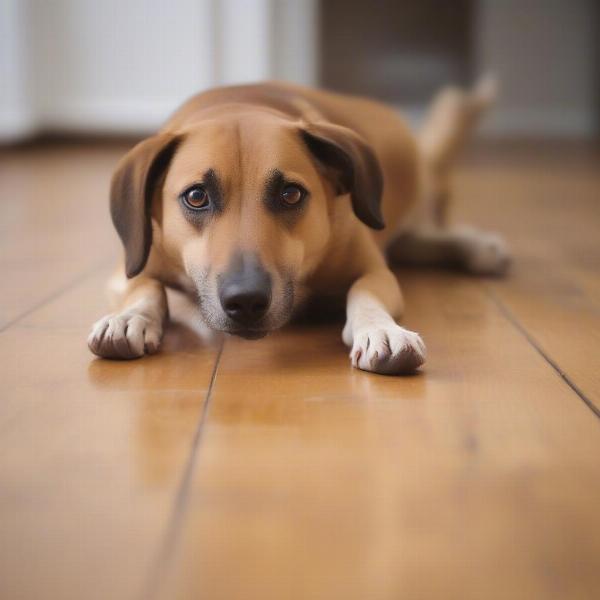Dogs slipping on wooden floors is a common problem, especially for older dogs, puppies, and certain breeds with shorter legs or smooth paw pads. This can lead to injuries, anxiety, and a general reluctance to walk on these surfaces. Understanding why your dog slips and implementing practical solutions can significantly improve their confidence and safety.
Why Do Dogs Slip on Wood Floors?
Several factors contribute to dogs slipping on wood floors. Smooth, polished surfaces offer little grip for canine paws, much like trying to walk on ice. This lack of traction can be exacerbated by a dog’s age, breed, and even nail length. Puppies, with their underdeveloped coordination, are particularly prone to slipping. Senior dogs often experience decreased muscle strength and joint stability, making them more susceptible to losing their footing. Breeds like Greyhounds and Whippets, known for their sleek physique and short coats, can also struggle with traction on slick surfaces.
 Dog slipping on wood floor
Dog slipping on wood floor
Simple Solutions to Improve Traction
Fortunately, there are several easy and cost-effective ways to improve traction for your dog on wooden floors. Rugs and runners are a quick fix, providing designated grip zones in high-traffic areas. Choose rugs with non-slip backings to prevent them from moving around and creating additional hazards. You can also explore the option of using dog-specific floor waxes that create a more paw-friendly, grippy surface. Regularly trimming your dog’s nails can also significantly enhance their grip. Long nails can force a dog’s paws to splay, reducing contact with the floor and increasing the risk of slipping.
Advanced Options for Enhanced Grip
For more persistent slipping issues, consider investing in dog socks or booties. These provide excellent traction and can be particularly helpful for senior dogs or those recovering from injuries. Look for socks or booties with rubberized soles for maximum grip. If you’re looking for a more permanent solution, you can also explore textured floor coatings or even replacing your flooring with a more dog-friendly alternative. For specific advice on flooring choices, see our article on the worst flooring for dogs.
Training and Conditioning for Better Balance
Alongside physical solutions, training and conditioning can improve your dog’s balance and coordination. Simple exercises like practicing sit-to-stands and encouraging slow, controlled movements on the slippery surface can build muscle strength and improve stability. You can also use positive reinforcement, rewarding your dog for walking confidently on the wooden floor. For dogs that struggle with stairs, consider using stair steps for dogs or dog steps for high bed to help them navigate these elevated areas safely.
Preventing Slips and Maintaining a Safe Environment
Preventing slips isn’t just about improving traction; it’s also about creating a safe environment. Keep floors clean and free of clutter, which could trip your dog. Ensure adequate lighting, especially in areas with stairs or changes in floor level. By proactively addressing potential hazards, you can minimize the risk of slips and falls.
Conclusion
Addressing the issue of dog slipping on wooden floor is crucial for their safety and well-being. By implementing a combination of practical solutions, training techniques, and environmental modifications, you can create a secure and comfortable space for your furry friend. Remember, proactive measures are key to preventing injuries and promoting confidence in your dog.
FAQ
- Why is my dog suddenly slipping on the wood floors? This could be due to a variety of reasons, including aging, nail length, or changes in floor polish.
- What are the best rugs for dogs on wood floors? Look for rugs with non-slip backings and durable, washable materials.
- Are dog socks effective in preventing slipping? Yes, especially those with rubberized soles. They provide excellent traction.
- Can I train my dog to walk better on wood floors? Yes, exercises like sit-to-stands and controlled walking can improve balance and coordination.
- What should I do if my dog falls and gets injured? Consult your veterinarian immediately for proper assessment and treatment.
- Are there any special floor waxes for dogs? Yes, some waxes are designed to create a more paw-friendly surface.
- What are the long-term consequences of dogs slipping on floors? Repeated slipping can lead to injuries, anxiety, and a reluctance to walk on certain surfaces.
ILM Dog is a leading international online resource for dog owners, dedicated to providing expert advice on all aspects of dog care, from breed selection and health to training and nutrition. We offer practical tips and resources to help you create a happy and healthy life for your furry companion. Whether you’re a seasoned dog owner or just starting your journey, ILM Dog is here to support you every step of the way. Contact us for further information at [email protected] or call us at +44 20-3965-8624. For more helpful articles and expert advice, visit ILM Dog.